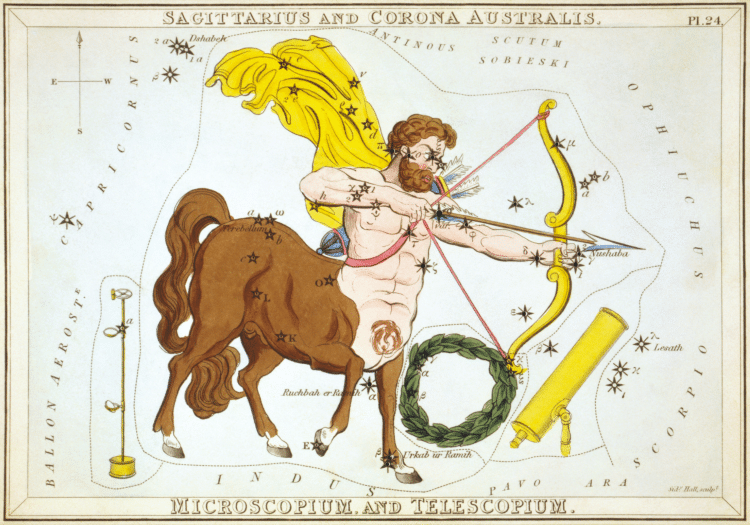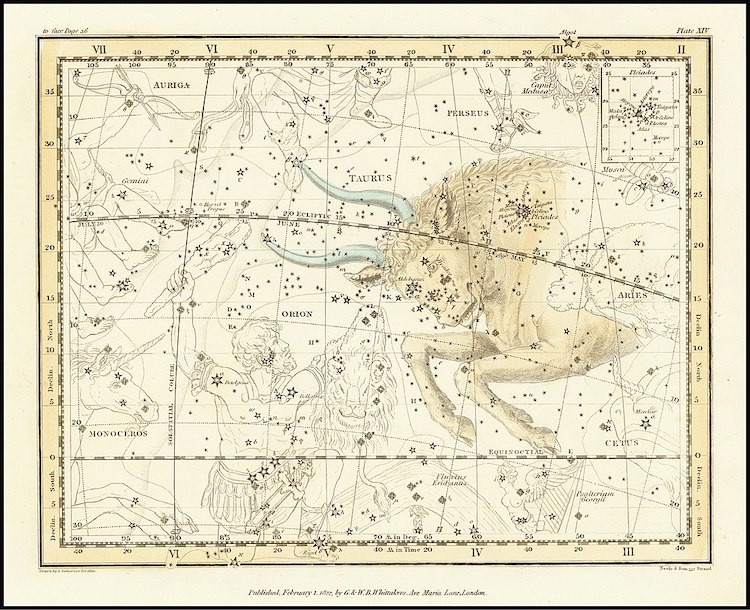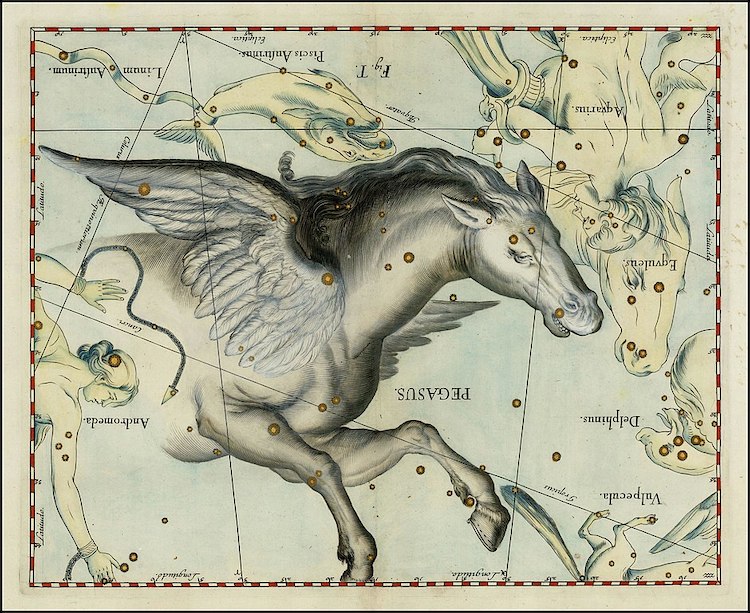

Have you ever looked up to the night sky and wondered how to identify famous star patterns? You may have heard of the “Big Dipper” or know the signs of the zodiac, but finding famous constellations among the stars requires knowledge of their fascinating history.
Ever since humans walked the Earth, great significance has been given to the celestial objects in the sky. Throughout history, names and mythical stories have been attributed to the star patterns, giving birth to what is now known as constellations. The International Astronomical Union lists 88 constellations—48 of which were recorded by Greek astronomer Claudius Ptolemy during the 2nd century.
For the Greeks, stars were a way of preserving folklore and mythology. The images depicted in their constellations are of heroes and beasts who received a place among the stars as tribute for their deeds on Earth.
Read on to discover the stories of some of the most famous constellations, as well as some tips for identifying them in the night sky.

Aquarius (Photo: Wikimedia Commons, Public domain)
Aquarius is one of the 12 constellations of the zodiac and is situated between Capricornus and Pisces. Aquarius was first recorded in the second century by the Greek astronomer Ptolemy, making it one of the oldest documented constellations. It’s also one of the biggest, spreading out over 980 square degrees. Despite its size, it can be difficult to see with the naked eye as there are no particularly bright stars that stand out. Aquarius is located near other water-related constellations—Cetus (the whale), Pisces (the fish), Delphinus (the dolphin), and Eridanus (the river)—in what is often referred to as the water or sea section of the sky.
The name Aquarius means “cupbearer” or “water bearer” in Latin. In Greek mythology, the constellation represents Ganymede, a handsome young man who was the object of Zeus’ affection. According to lore, he was brought to Mount Olympus where he served as cupbearer to the gods and was granted eternal youth.
Aquarius can be seen in the spring in the Southern Hemisphere and the fall in the Northern Hemisphere.

Aries (Photo: Wikimedia Commons, Public domain)
Located in the Northern celestial hemisphere between Pisces and Taurus, Aries is a zodiac constellation that was one of 48 constellations described by Ptolemy. Though now known as a ram, in Babylonian times, Aries was known as “The Agrarian Worker” and was featured in an agricultural calendar.
The transformation of the constellation into a ram likely occurred in later Babylonian times when it was closely associated with the figure of a shepherd. In ancient Greek mythology, Aries was connected with a golden ram that rescued Phrixus and Helle, the twin sons of a king, on the orders of Hermes.
Aries has three major stars that form an asterism, or pattern of stars—Hamal, Sheratan, and Mesarthim. Hamal is the brightest star and the 48th brightest in the sky. Its name is taken from the Arabic word meaning “lamb” or “head of the ram.” The constellation is visible in both the Northern and Southern hemispheres. It's easiest to view it in the Northern Hemisphere in autumn and winter, while spring to mid-summer are the easiest times to spot it in the Southern Hemisphere.

Cancer (Photo: Wikimedia Commons, Public domain)
Cancer, meaning “crab” in Latin, is the fourth sign of the zodiac. It’s one of the dimmest constellations, featuring only two stars above the 4th magnitude (measurement of brightness). The Cancer constellation occupies an area of 506 square degrees and lies between Leo and Gemini.
In Greek mythology, Cancer represents the giant crab that attacked Hercules during the second of the 12 labors he performed as punishment for killing his family. It was sent by the jealous goddess Hera to hinder Hercules as he battled the water serpent Hydra, but he killed it with his club.
Cancer is visible in the Northern Hemisphere in the early spring. It can be seen in the Southern Hemisphere during autumn. When trying to find it, don’t expect to find the shape of a crab in the sky—it looks more like a faint, upside-down Y.

Cassiopeia (Photo: Wikimedia Commons, Public domain)
With its distinctive “W” shape formed by five bright stars, Cassiopeia is one of the most easily recognizable constellations in the northern night sky.
The constellation is named after the vain queen Cassiopeia in Greek Mythology, wife of the King Cepheus of Aethiopia. As the legend goes, Cassiopeia boasted that she was more beautiful than the sea nymphs called the Nereids. Her claim angered Poseidon, god of the sea, who sent a sea monster called Cetus to destroy the kingdom. Cassiopeia’s daughter, Princess Andromeda, was left bound to a rock as prey for the monster, but she was rescued by Perseus the Hero whom she later married.
Cassiopeia, Cepheus, and Princess Andromeda were all elevated to the sky as stars. Only Cassiopeia suffered humiliation; she was forced to wheel around the North Celestial Pole on her throne, spending half of her time upside-down, clinging to it so she does’t fall off.
Cassiopeia can be found high in the northeastern sky on October evenings, not far from Polaris, the North Star.

Gemini (Photo: Wikimedia Commons, Public domain)
Gemini is one of the constellations of the zodiac and is located in the Northern Sky. Gemini is the 30th largest constellation in the sky, occupying an area of 514 square degrees.
Gemini means “the twins” in Latin. The constellation represents the twins Castor and Polydeuces (or Pollux) in Greek Mythology. The twins’ mother, Spartan Queen Leda, was seduced by Zeus, who visited the queen in the form of a swan. She became pregnant with the immortal Polydeuces and Helen (who later became the legendary Helen of Troy). Leda later also became pregnant with Castor and Clytemnestra. These siblings were fathered by Tyndareus and, unlike Zeus’ children, they were mortal.
Despite having different fathers, Castor and Polydeuces grew up together and were very close. One day, the brothers clashed with another set of twins, Idas and Lynceus, when they fought over two women, Phoebe and Hilaira. Lynceus killed Castor by stabbing him with a sword. Devastated Polydeuces asked Zeus to share his immortality with his murdered brother and the god placed them both in the sky, where they remain inseparable as the constellation Gemini.
The Gemini constellation is best viewed is during February. Look northeast of the constellation Orion and between the Taurus and Cancer constellations and you should find its two bright stars representing Castor and Pollux. Alongside them are a couple of star lines forming their bodies, giving the constellation a rough “U” shape.

Sagittarius (Photo: Wikimedia Commons, Public domain)
One of the constellations described by Ptolemy, Sagittarius is located in the Southern celestial hemisphere. Latin for the word “archer,” Sagittarius is usually depicted as a centaur with a bow and arrow. It sits right in the center of the Milky Way between Scorpius and Ophiuchus and is easy to spot for the “teapot” pattern created by its brightest stars.
The story behind this famous constellation is based on Sumerian mythology, and there are different interpretations. The most common is that Sagittarius is Crotus, a mythological character who was a satyr that lived among the Muses. He is credited by the Greeks as inventing archery and asked Zeus to place him in the sky where he could show off his skills. A second story states that Sagittarius is the centaur Chiron, who transformed himself into a horse to escape his jealous wife, though some associated Chiron with another constellation Centaurus.
Sagittarius is visible in most of the Northern Hemisphere in the summer, with August being the best month for viewing. Winter is the best time to view the constellation in the Southern Hemisphere.

Taurus (Photo: Wikimedia Commons, Public domain)
The constellation Taurus, also known as “the bull,” is one of the oldest and most recognizable constellations. Covering over 797 square degrees, it is most famous for its giant red star called Aldebaran. It forms the bull’s right eye and is the brightest star in the constellation as well as the 14th brightest star in the sky.
In Greek Mythology, there are several stories involving the bull. In the most famous, Zeus transformed himself into a white bull with golden horns named Taurus after fell in love with the Phoenician Princess Europa. He used the disguise to carry Europa away to Crete on his back.
The Taurus constellation is fairly easy to find due to its bright Aldebaran star and its prominent “V” shape which represents the head and horns of the bull. In the Northern Hemisphere, the bull charges through the sky from November to March, but the constellation is at its most visible in January.

Ursa Major (Photo: Wikimedia Commons, Public domain)
The Big Dipper is often mistaken for its own constellation, but it's actually an asterism within the constellation of Ursa Major. Always visible in the Northern Hemisphere, it’s one of the most recognized star patterns. Its name in Latin means “greater bear” or “she bear.”
As the Greek myth goes, Zeus fell in love with a young nymph named Callisto. Hera, Zeus’s wife, was jealous and transformed Callisto into a bear. While she was in animal form, she came across her son Arcas, but he didn’t recognize the bear as his mother and tried to shoot her. Zeus intervened and turned Acras into a bear too. He placed Callisto (Ursa Major) and her son (Ursa Minor) permanently in the night sky.
The seven brightest stars of the Big Dipper form part of the backside and tail of the large bear, while other smaller stars make up the rest of its shape. Ursa Major, or the “Great Bear,” is best viewed during April.

Ursa Minor (Photo: Wikimedia Commons, Public domain)
Ursa Minor, meaning “lesser bear” in Latin, represents Callisto’s son Arcas in Greek Mythology.
Ursa Minor, also known as the Little Dipper, is famous for containing Polaris, the North Star. The constellation is visualized as a baby bear with an unusually long tail. It can be distinguished from the Big Dipper not only by its smaller size but by the up-turned curvature of the tail.
Like Ursa Major, this constellation is visible all year round. When you’ve found the North Star at the end of the bear’s tail, it’s then easy to identify the rest of the constellation.

Canis major (Photo: Wikimedia Commons, Public domain)
Latin for “greater dog,” Canis Major is a Southern celestial hemisphere constellation. Along with Canis Minor, it's typically seen as a dog following the hunter Orion. This constellation contains the brightest star in the night sky, Sirius.
Canis Major is often shown chasing a hare, which represents the Lepus constellation next to Orion. In Greek mythology, Canis Major represents Laelaps, a skilled hunting dog that was a gift from Zeus to Europa. Eventually it found its way into the hands of Procris, an Athenian princess. Her husband Cephalus took the dog out to hunt down a fox that no one could catch. The endless hunt went on for so long that Zeus elevated the dog into the sky in order to end it.
The Big Dog is visible in the Northern Hemisphere from December to March and in the Southern Hemisphere from November to April. Thanks to Sirius, it's fairly easy to spot. Just look at Orion's belt and draw an imaginary diagonal line down to the left. This will lead you to Sirius, which is the dog's chest.

Pegasus (Photo: Wikimedia Commons, Public domain)
Pegasus is one of the most prominent constellations in the northern sky. It was listed by the astronomer Ptolemy during the 2nd century and was named after a winged horse in Greek mythology. The brightest star in the constellation is Epsilon Pegasi, which forms the creature's nose.
Pegasus belonged to Poseidon, the god of the sea, earthquakes, and storms. In a battle between Perseus and Medusa, Perseus decapitated her and the winged horse “sprang” from her blood.
Pegasus was stolen by the Greek hero Bellerophon with the help of Athena and Poseidon. Pegasus allowed Bellerophon to ride him in order to defeat the monstrous Chimera. However, Bellerophon later fell from the creature’s back while trying to reach Mount Olympus. After some time, the riderless Pegasus reached Olympus and Zeus transformed him into the famous constellation. Pegasus was also known for bringing thunder and lightning to Zeus whenever he needed it.
In the Northern Hemisphere, the Pegasus constellation can be found high in the sky from the end of summer through autumn. If you are below the equator, look for Pegasus from late winter until spring.

Virgo (Photo: Wikimedia Commons, Public domain)
Covering 1,294 square degrees, Virgo is the largest constellation of the zodiac and the second-largest constellation overall. The Virgo name is Latin for “virgin.”
The constellation Virgo is often said to personify Persephone, the daughter of Demeter, the harvest goddess. According to the Greek myth, Earth experienced eternal spring until the pivotal day when the god of the underworld abducted Persephone, the maiden of spring. Demeter was so saddened by the loss that she abandoned her role as the goddess of fruitfulness and fertility. In some parts of the world, winter turned the terrain into an icy wasteland, and elsewhere the sun scorched the earth and destroyed the harvest.
Luckily, Zeus, the king of the gods, intervened when he insisted the god of the underworld return Persephone to Demeter. He also ordered that Persephone abstain from food until her return. The god of the underworld tricked Persephone by giving her a pomegranate, knowing she would eat it on her way home.
Persephone returned to her mother, but because she ate the pomegranate, she was punished and bound to return to the underworld for four months every year. To this day, spring returns to the Northern Hemisphere when Persephone is reunited with Demeter, but winter prevails when she dwells in the underworld.
From the perspective of the Northern Hemisphere, Virgo is absent from the sky during late autumn, winter, and early spring. However, by March and April the constellation is visible all night. Virgo can easily be spotted thanks to its bright blue-white star, Spica.

The Orion constellation is named after Orion the hunter in Greek mythology. Located on the celestial equator and made up of bright young blue giants or supergiants, it is one of the most prominent and recognizable constellations in the sky and can be seen throughout the world.
In mythology, Orion was a supernaturally gifted hunter who was the son of Poseidon. He proclaimed himself as the greatest hunter in the world. This angered Hera, the wife of Zeus, who had a scorpion kill him (this later became the constellation Scorpius). Out of compassion, Zeus put Orion into the sky.
Orion’s Belt includes the three most prominent stars in the constellation: Alnilam, Mintaka, and Alnitak. Betelgeuse, the second-brightest star in Orion, marks the right shoulder of the hunter, and Bellatrix serves as his left shoulder. The Orion Nebula acts as the middle “star” in Orion’s sword, which hangs off Orion's Belt. In the sky, Orion is posed fighting against Taurus the bull with a shield and club.
Orion is clearly visible in the night sky from November to February. It can be found in the southwestern sky if you are in the Northern Hemisphere or the northwestern sky if you are in the Southern Hemisphere.
The article has been edited and updated.
Emma Taggart is a Contributing Writer at My Modern Met. Originally from Northern Ireland, she is an artist now based in Berlin. After graduating with a BA in Fashion and Textile Design in 2013, Emma decided to combine her love of art with her passion for writing. Emma has contributed to various art and culture publications, with an aim to promote and share the work of inspiring modern creatives. While she writes every day, she’s also devoted to her own creative outlet—Emma hand-draws illustrations and is currently learning 2D animation.